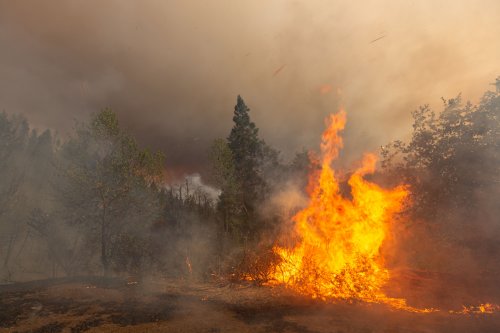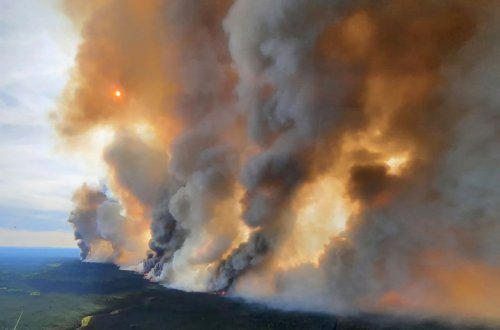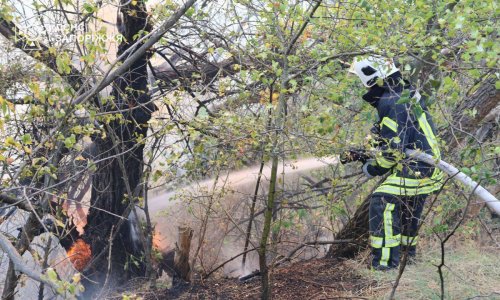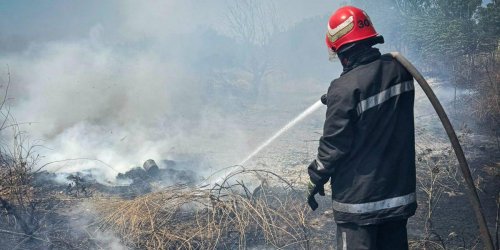In Ukraine during the week of July 28 – August 3, 2022 russian troops continued to commit crimes against the environment. According to the estimates of the KSE Institute, the Ministry of Reintegration and the Ministry of Regional Development, as of August 1, due to hostilities in Ukraine, at least 388 enterprises and 28 oil depots were damaged, destroyed or seized.
Starting August 2, the updated Air Raid app will warn of chemical threats and radiation hazards, as well as send text messages with recommendations for actions depending on the type of threat, reports Ministry of Natural Resources.
Ukraine also enlisted the support of the Czech Republic for the post-war restoration of the environment.
The material emphasized that every Ukrainian has the opportunity to report the fact of an environmental crime using a web resource ecozagroza.gov.ua and mobile application "EcoHazard".
Threats to nuclear and radiation safety
The artillery strikes Russian troops are carrying out from Europe's largest Zaporizhzhia NPP underline russia's irresponsible attitude to nuclear safety. This was stated by U.S. Secretary of State Antony Blinken on August 1 during his speech at the UN Nuclear Non-Proliferation Treaty Review Conference.
According to him, russia is now using the plant as a military base to fire at Ukrainians, knowing that they can’t and won’t shoot back because they might accidentally strike a nuclear – a reactor or highly radioactive waste in storage. That brings the notion of having a human shield to an entirely different and horrific level.
On August 1, the Director General of the International Atomic Energy Agency (IAEA), Rafael Grossi, expressed his concern about the threats to the nuclear and physical safety of ZNPP. According to him, the situation at the Zaporozhye NPP is becoming more and more threatening every day.
Attacks on infrastructure and industrial facilities
July 28th the occuppiers:
- launched a massive rocket attack on Mykolaiv, damaging the warehouse of an agro-industrial enterprise and industrial facilities;
- launched missile attacks on Kropyvnytskyi, damaging buildings and equipment of an aviation enterprise;
- shelled an agricultural enterprise in Shestirna, the Dnipropetrovsk region. The shelling caused a fire that destroyed 10 tons of wheat;
- shelled the Nemyshlyansky and Kyiv districts of Kharkiv, as well as Chuguiv, Eskhar, Bezruky, Udy, Prymorske, Tsyrkuny, and Pechenihy in the Kharkiv region, damaging the premises of several enterprises;
July 29 the occuppiers:
- attacked Nikopol in the Dnipropetrovsk region with MLRS, damaging industrial facilities;
- launched a missile attack on the city of Bogodukhiv, the Kharkiv region, damaging the premises of a food enterprise;
- carried out numerous shellings in the Donetsk region, in particular, the Avdiivka coke-chemical plant came under fire.
July 30 the russian military:
- launched a missile attack on the territory of the Malyshev State Enterprise in Kharkiv;
- shelled the Nikopol district of the Dnipropetrovsk region with Grad MLRS. In particular, rockets hit the administrative building of an enterprise, causing a fire;
- shelled 17 settlements in the Donetsk region, in particular, the railway infrastructure and a coke-chemical plant;
On July 31, russian troops damaged an industrial building in Kharkiv's Nemyshlianskyi district. A large-scale fire broke out: equipment and printing products burned.
August 1 russian troops:
- hit the Merefa glass factory in the Kharkiv region with three rockets. A fire broke out in an area of about 100 square meters;
- shelled a warehouse in Mykolaiv with humanitarian aid. Medicine and food supplies were destroyed by fire.
On August 2:
- as a result of russian shelling, the production premises were damaged at a factory in Chuguiv, the Kharkiv region;
- as a result of russian shelling, a fire broke out at the oil terminal in the port of Mykolaiv.
On August 3, as a result of a russian missile strike, a factory in the Novobavarsky district of Kharkiv was partially destroyed. The rocket hit one of the workshops with an area of about 6,000 sq. m.
Large-scale fires at infrastructure and industrial facilities lead to air poisoning with highly hazardous substances that can be transported over long distances.
Pollution directly caused by fighting
According to Ukraine’s State Emergency Service (SES), from 24 February to 3 August 2022, 173,705 explosive devices, including 2,099 aircraft bombs, were neutralized in Ukraine. An area of 67 440 hectares was surveyed for explosives.
According to the General Staff of the Armed Forces of Ukraine, in July, Russia carried out 49 missile and 44 air strikes on Ukraine. Since the beginning of the full-scale invasion, the aggressor country had lobbed more than 3,000 missiles at Ukraine. 74% of them hit objects of civil infrastructure - residential premises, schools, hospitals, shopping centres, and cultural centres, which have nothing to do with the war.
Airborne releases from rocket attacks can cause illness and even death.
Rocket attacks and the resulting fires have the following environmental impacts:
- emissions of fine dust,
- the release of large amounts of nitrogen dioxide, organic matter, black carbon and toxic dust into the atmosphere during and after fires resulting from shelling.
- fires in buildings insulated with hazardous polystyrene foam release large amounts of polycyclic compounds and deadly hydrocyanic acid.
According to the assessment conducted by the KSE Institute, the Ministry of Reintegration of Temporarily Occupied Territories, and the Ministry for Communities and Territories Development, as of August 1, at least 129,900 residential buildings were destroyed and damaged due to military actions in Ukraine, of which 114,700 were private houses and 15,100 were multi-apartment buildings. The destruction of buildings and settlements leads to environmental pollution with construction debris and asbestos. The consequences of such pollution for the environment will be felt for years.
Harm to nature reserves and protected ecosystems
On July 27, russian troops carried out a mortar attack on the Shalygin Forestry, located in the Sumy region, right on the border with Russia. Fortunately, the foresters at the forestry premises were not injured.
On July 28, more than 20 missiles from the S300/S400 anti-aircraft missile systems fell into a forest in the area of the Goncharivska territorial community of the Chernihiv region.
On July 31, after a large-scale shelling of the Mykolayiv region, forest fires broke out.
On July 31, the russians shelled and damaged the territory of the Desnyansk-Starogutsky National Nature Park in the Sumy region.
Since July 31, the russian military has been shelling the Kinburn Spit, which led to forest fires over large areas. Employees of the state protection service of the regional landscape park, together with the local community, employees of the national park and the forestry enterprise, are involved in extinguishing fires and eliminating fires. But fires reappear, and pose a threat not only to natural complexes, but also to villages and people's lives.
After the fires, nature will recover for decades. The charred tree trunks of the Dead Black Forest, if not removed, will turn into humus for years.
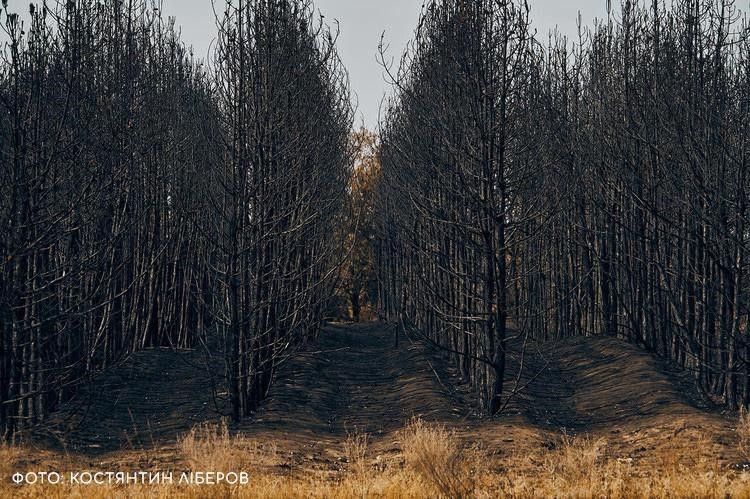
Harm to water resources
Russian troops are deliberately striking at the infrastructure for water intake, purification, and supply, as well as sewage treatment facilities. Due to the Russian aggression, water supply and sewerage facilities in the Luhansk, Donetsk, Zaporizhzhia, Kharkiv, and Mykolaiv regions have been significantly damaged.
According to the UN, some 13 million people in Ukraine are in need of water, sanitation, and hygiene assistance. These include internally displaced people in collective centres and host communities, people affected by damages to systems and limitations in water treatment consumables.
On July 30, the power supply to the Karlivka filter station in the Donetsk region was restored, but the situation may change at any moment. Currently, the filter station is under constant fire, so the water supply may be suspended.
In June and July, in the Seversky Donets basin, where drinking water is taken for the entire Donbass, they found mercury pollution, excess nitrogen and nitrite levels, as well as traces of oil products that had never been recorded before.
In particular, in July, at the mouth of the Sukhoi Torets River, an 8.4-fold excess of mercury concentration was detected (0.59 µg/dm3 versus 0.07 µg/dm3 allowed). In June, in the area of drinking water intake not far from Slovyansk, ammonium nitrogen and nitrites were found in water samples, respectively, 2.4 and 2.8 times more than the average annual values. Also, oil products were found in the water at a concentration of 0.028 mg/dm3. In previous years, they were not found at all in the areas of surface drinking water intakes of the Seversky Donets. In all likelihood, these are the consequences of fighting along the main riverbed of the Ukrainian East.
Since the start of russia's full-scale war against Ukraine, due to shellings at least 10 coal mines in the Donbas area controlled by the Ukrainian government have been flooded. Mine waters may contain heavy metals polluting the environment.
Black and Azov seas
Maritime traffic from all Ukrainian ports in the Black Sea remains under threat due to mining.
On July 28, two people were blown up by a sea mine in Koblevo, the Mykolaiv Region.
On July 28, as a result of an unknown explosive device detonation, a small hydrographic vessel was damaged near the Bystre estuary of the Danube.
On July 30, an anchor mine was located near the coast in the Bilgorod-Dnister district in the Odesa region. The dangerous object was neutralized directly in the water – a few meters from the shore.
On July 31, as a result of a collision with an unidentified explosive device near the Bystre estuary of the Danube, the Orlyk pilot boat suffered damage. Passage through the Bystre estuary for ships was temporarily restricted. On August 2, a floating crane hit an unknown explosive device in the same area.
Dolphins continue to die in the Black Sea due to hostilities. On July 29, 2 dead dolphins (a common white-sided dolphin and a harbour porpoise) were found on the coast of the Tuzly Estuaries National Nature Park. Another dead white-sided dolphin was washed up on the beach in Odesa. Since the beginning of the war, 32 dead dolphins have already been found in part of the territory of the Tuzly Estuaries National Nature Park.
The Czech Republic will help Ukraine in green post-war reconstruction. The environment, in particular, will support nature parks, climate policy, waste management reform and the fight against industrial pollution.
As EcoPolitic reported earlier, in the Zhytomyr region, environmental inspectors calculated over 525 million hryvnia losses, which russian troops inflicted on the environment.

